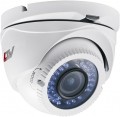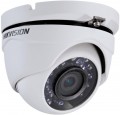Illumination range
Operating range of the backlight (see "Design and capabilities") installed in the surveillance camera. This term usually means the maximum distance from the camera to the observed object, at which it is able to provide a relatively high-quality and legible image in the complete absence of other light sources. Of course, the actual backlight range may differ from the claimed one, and these differences are most often in the direction of increase (for example, due to the presence of the same additional light sources). However, if the possibility of shooting with backlight is important for you, you should focus on the claimed range.
Matrix size
The size of the matrix installed in the surveillance camera (diagonally).
In general, larger sensors (with the same resolution and sensor type) are considered more advanced: they get more light, which has a positive effect on image quality (especially in low light). On the other hand, increasing the size affects the cost of the entire device; and in some cases (for example, if the camera is not planned to be used in twilight and darkness), a relatively small sensor may be quite suitable.
As for specific dimensions, the most modest cameras in terms of this indicator have matrices of
1/4 "or less. Models with sensors of
1/3.8" - 1/3" and
1/2.9" - 1/2" are very popular, these values can be called average. And in advanced devices, diagonals and
more than 1/2 "(up to 1/1.7") are found.
Focal type
Type of camera lens by focal length. Here are the options:
— Permanent. Fixed focal length lenses have a fixed angle of view — in other words, they work at a constant zoom level and are not able to change it (the only option available for such cameras is electronic zoom). The advantages
of CCTV cameras with a fixed focal length are simplicity, reliability, almost zero power consumption, small size and low cost. The main disadvantage is the inability to work with optical zoom (see below); and said electronic magnification is less advanced, since when approaching, the clarity of the “picture” decreases.
— Variable (varifocal cameras). Zoom
lenses are more complex than "fixed" lenses, are larger, are considered somewhat less reliable, and are noticeably more expensive. However, this type of optics has an important advantage: it is the only one capable of providing optical zoom (see below), which allows you to “zoom in” the image without compromising its quality.
Focal length
Focal length of the camera lens.
The focal length is such a distance from the lens to the matrix, at which a clear image is obtained on the matrix (when the lens is focused to infinity). The viewing angles of the lens primarily depend on this indicator (see below): the smaller it is, the wider the viewing angles and the smaller the objects in the frame (and vice versa). At the same time, it should be noted that the actual viewing angle is determined not only by the focal length, but also by the size of the matrix (see above). In fact, this means that with different sizes of matrices, lenses with the same focal length will have different working angles. Therefore, only cameras with the same matrix size can be compared with each other according to this indicator. Among CCTV cameras, lenses with a focal length of
2.8 mm,
3.6 mm,
4 mm and
6 mm are considered popular.
In models with a variable focal length (see above), in this case, the range from the minimum to the maximum distance is indicated. Also, using these data, you can derive the optical magnification factor of such a lens: for this, the maximum value must be divided by the maximum (for more details, see below).
Horizontal viewing angle
Horizontal viewing angle of the surveillance camera. For models with a variable value, the maximum value is indicated, since it is the width of the image that is important, and when zooming in, the zoom factor is more important than the angle. This paragraph also indicates the general angle of view for models with a circular field of view – in particular, cameras with a fisheye lens (see above)
The wider the viewing angle, the more space the camera captures and at the same time, the smaller the images of individual objects in the frame are obtained. Therefore, when choosing by this parameter, it is worth deciding what is more important – the ability to view a large scene or the visibility of small details in a relatively narrow field of view. Also note that with a wide field of view (100° or more), characteristic distortions can be observed at the edges of the frame, and the wider the angle, the more pronounced they are. This phenomenon can be eliminated by panoramic shooting (see "Design and features"), but this feature, in turn, complicates and increases the cost of the camera.
Maximum humidity
The highest relative humidity at which the camera is able to operate normally, without failures and breakdowns, for an unlimited time.
Modern electronics tolerate low humidity well, but high rates affect it negatively — with a long stay in such an atmosphere, moisture can condense on certain parts of the structure and various unpleasant consequences, from corrosion to short circuits and fires. Therefore, you can use the camera effectively and safely only in conditions where the humidity does not exceed the maximum recommended value specified in the specifications. At the same time, we note that many devices are able to endure short-term (up to several hours) exposure to high humidity without consequences.
Protection level
The degree of protection of the camera against moisture and foreign objects according to the IP standard.
This protection describes how well the camera body protects sensitive internal components from the impacts mentioned. By default, it is denoted by the letters IP followed by two numbers. The first digit means protection against the ingress of solid objects and dust, and the following levels of protection correspond to its individual values:
1 — protection against objects with a diameter of more than 50 mm (large body surfaces)
2 — from objects with a diameter of more than 12.5 mm (fingers, etc.)
3 — from objects larger than 2.5 mm (most instruments)
4 — from objects more than 1 mm (almost all tools, most wires)
5 — dustproof (full protection against contact; dust can penetrate inside, but does not affect the operation of the device)
6 — dust tight (case with full protection against dust and contact).
The second digit characterizes the protection against moisture, here the values \u200b\u200bcan be as follows:
1 — protection against vertically falling drops of water;
2 — from water drops with a deviation of up to 15 ° from the vertical axis of the device;
3 — from water drops with a deviation of up to 60 ° from the vertical axis of the device (the minimum level that allows you to operate the camera in the rain);
4 — from splashes from any direction;
5 — from jets from any...direction;
6 — from sea waves or strong water jets;
7 — the possibility of short-term immersion to a depth of 1 m (without the possibility of continuous operation in immersed mode);
8 — the possibility of long-term immersion to a depth of more than 1 m (with the possibility of continuous operation in immersed mode).
Of course, surveillance cameras are usually not designed for immersion under water — the last two options only characterize a high degree of moisture resistance.
In some models, one of the numbers may be replaced by the letter X — for example, IPX7. This does not mean that there is no protection, but that the corresponding parameter was not certified according to the IP standard. At the same time, the degree of non-certified protection can be quite high — for example, the example above corresponds to the possibility of complete immersion under water, which requires a high degree of closeness (minimum dust resistance level 5). Also note that the complete absence of IP marking also does not mean that the camera is absolutely not protected from negative influences — again, the point is that the case simply did not pass official certification. However, if dust and water protection are critical, you should choose among models with IP certification.
Material
The main material used in the construction of the camera body.
— Plastic. Inexpensive and at the same time quite practical material. Plastic is light, quite strong (not as strong as metal, but still quite sufficient for most cases), chemically inert (and therefore not susceptible to corrosion and insensitive to moisture), and also has a relatively low thermal conductivity (which provides additional protection for extreme temperature fluctuations). Due to all this, this material is very popular in indoor chambers (see "Usage"). At the same time, it is somewhat less suitable for outdoor work.
— Metal. The main advantage of metal, in comparison with plastic, in the case of surveillance cameras is high strength and reliability. This allows you to use it even for street models that work in difficult conditions and must have a certain anti-vandal resistance (at least not immediately “give up” when trying to break or break). At the same time, such material is much more expensive, and therefore less common.

